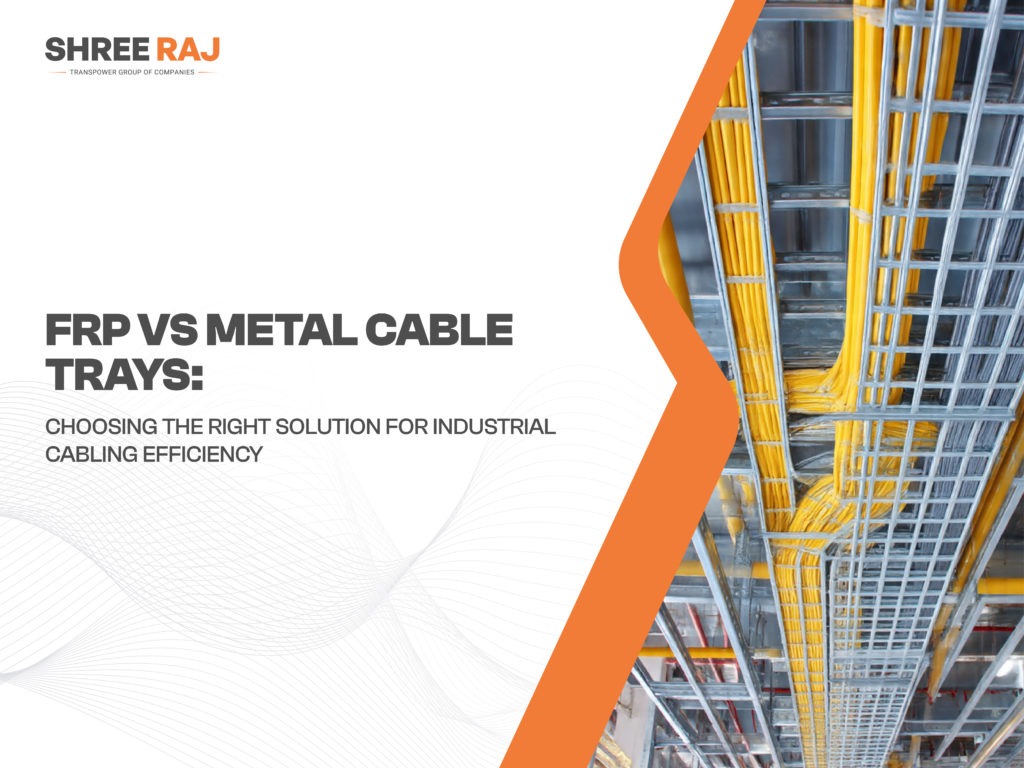
In an industrial setup, safe and efficient cable management is important. The right type of cable tray ensures systematic wiring, easy maintenance, and long-term security against environmental and mechanical stress. The most common materials used today are FRP (fiberglass reinforced plastic) and metals. According to NEMA cable tray standards, proper tray design ensures safety, load balance, and long-term performance in industrial setups.
In Shreeraj Traders, we specialize in FRP cable trays designed for stability, safety, and performance under challenging industrial conditions. But how is the FRP tray actually compared to the metal – and which is better for your application? Let’s know
Cable trays form the backbone of power and control wiring systems in plants, factories, and infrastructure projects. They help to route electrical wires neatly, avoid clutter, and ensure safe distribution among various devices.
By supporting heavy cable loads, improving ventilation, and reducing maintenance time, cable trays are essential for both safety and efficiency. However, the choice of material determines how well these trays perform in real-world conditions.
The FRP cable tray is made of reinforced fiber filament with a polymer resin, which makes a strong, non-metallic overall. This modern material provides many unique benefits that make it ideal for an industrial environment.
One of the most notable benefits of the FRP tray is its resistance to war. Unlike a metal tray, FRP does not rust even when exposed to moisture, chemicals, or salt-laden air. This makes them perfect for chemical industries, refineries, coastal installations, food processing units, and water treatment plants.
FRP trays are also light, making them easier to handle and install. It reduces labor costs and installation time, especially in overhead or large-scale projects. Despite being light, the FRP trays are strong enough to support the standard industrial cable load when designed properly.
Another major benefit is his non-complex nature. FRP trays do not generate electricity, which significantly reduces the risk of electric shocks or grounding issues. This makes them safe to install and maintain, especially in a high electrical risk environment.
Finally, the FRP tray requires minimal maintenance. They do not require painting, coating, or galvanizing, and they can last for years with maintenance, providing long-term value.
Metal trays – usually made of galvanized steel, stainless steel, or aluminum – have been the traditional choice for decades. They are known for their high mechanical strength, making them suitable for heavy cable loads and long-term installations.
In high-temperature environments, metal trays perform well because they can withstand extreme heat without deforming. They are also non-flammable, which can be beneficial in fire-prone areas.
However, metal trays come with drawbacks. They are sensitive to corrosion, especially in humid or chemical environments. Even when galvanized or coated, the protective layer can wear down over time, causing rust. This not only weakens the tray but also affects the safety and appearance of the system.
Metal trays are also heavier, meaning they require more effort and stronger support structures during installation. Additionally, since metals conduct electricity, proper grounding and bonding are essential to ensure operator safety and system integrity.
The answer depends on your industrial environment, budget, and performance needs.
If your facility is exposed to moisture, chemicals, or salty air, FRP cable trays are the clear winner. Their corrosion resistance and non-conducting properties ensure long-lasting performance with minimal maintenance.
If your project demands very high mechanical strength or long unsupported spans, metal trays can provide a structural advantage.
However, you should invest in corrosion protection and regular inspections to maintain safety and lifespan.
For most modern industries – especially those focused on sustainability and safety – FRP trays strike the perfect balance between strength, durability, and ease of installation. They also offer a cleaner appearance and require almost no post-installation care.
Whether you choose FRP or metal, adhere to good installation practices for maximum display and safety:
By following these steps, you can increase the life of your cable support system and maintain reliable power distribution in your entire facility.
Among Shreraj traders, we understand that every industrial environment has unique challenges. This is why we provide high-quality FRP cable trays that add strength, safety, and durability. Our trays are designed to resist rust, face high loads, and perform firmly in a rigid environment.
We supply a wide range of ladder-type, perforated, and fire-resistant FRP cable tray, as well as all essential accessories and fittings for easy installation. With our technical expertise and commitment to quality, we help industries to get safe and skilled cabling systems that stand the test of time.
Both FRP and metal cable trays have their own strengths. Metal trays offer unmatched mechanical strength, while FRP trays excel in corrosion resistance, safety, and maintenance-free performance.
For industries seeking a modern, long-lasting, and cost-effective solution, FRP cable trays from Shreeraj Traders are the smarter choice. They not only ensure safe and efficient cabling but also deliver peace of mind through years of dependable performance. For more details, contact our support team.
WhatsApp us